The Best Men’s Winter Running Gear of 2023
This article originally appeared on Outside
As a lifelong New Yorker, I've run through the highly variable conditions of nearly 30 northeastern winters. Each year, my cold-weather kit becomes a little more dialed as apparel technology develops and as I pick up new tips and tricks from local runners. Here is the cream of this year's crop--versatile running apparel pieces that will keep you covered from head to toe in a huge variety of conditions, and stand the test of countless miles of winter training, from first frost straight through to mud season.
Related: The Best Women's Winter Running Gear of 2023
How We Test
Number of testers: 3
Number of products tested: 70
Number of miles: 741
Vertical feet: 67,000
Highest run: 12,600+ feet
I enlisted two other veteran runners--one in northern Arizona and another in the Colorado Rockies--to help me put dozens of pieces of winter running apparel through their paces over several months last winter and early spring. I tested them on the village streets, rolling country roads, and forested technical trails around my upstate New York home. My partners played with them on a mix of urban streets and buff mountain trails in their respective desert and high-mountain locales. We ran on bluebird days when it hit 50 degrees Fahrenheit above 6,000 feet, and on blustery gray days where windchills dipped well below zero. Along the way, we filled out feedback forms scoring each item's warmth, breathability, stretch, durability, and fit; discussed its notable sport-specific features; called out any shortcomings; and asked the all-important question: would we buy this piece ourselves?
Meet Our Lead Tester
Peter Koch
Peter Koch started running as a teenager, but only became a full-blown endurance freak eight years ago, when a local running club invited him to train for the Philadelphia Marathon. Since then, he's raced five marathons and run many more ultra-distance events, including his annual birthday tradition of running his age (no, it's not getting easier). Though not overly selective regarding his outdoor pursuits--he rides any two-wheeled rig, happily paddles whatever floats, runs roads as readily as trails, and defines his favorite ski terrain as "snow"--he stubbornly requires they meet two simple criteria: they're human-powered (ideally) and fun (definitely).
Reviews: The Best Men's Winter Running Gear of 2023
Daehlie Coverage Jacket ($120)
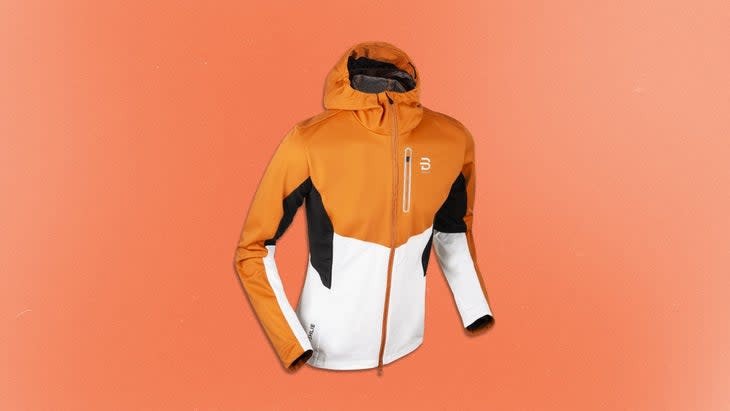
Weight: 10.8 oz
Sizes: S-XXL
At least half of cold-weather run comfort has to do with managing airflow--releasing excess body heat while sealing out icy drafts so you feel protected without overheating--and finding the right jacket is often the trickiest part of that equation. The full-featured Coverage is a well-ventilated, lightweight, and breathable hooded softshell that handles that singular task brilliantly. Made from stretchy, fast-drying polyester, it has massive mesh underarm panels that release excess moisture and body heat where you most need to lose it. At the same time, mesh inner cuffs prevent freezing wind from blowing up the sleeves, and a structured hood--one of the best we've used--with cinch-down draft stopper does the same job up top. Sporting wind- and water-repellent three-layer construction, this nifty run jacket has kept us warm and dry in all but the wooliest of winter weather.
Bottom Line: A storm shelter that leaves you high-and-dry
Tracksmith Fells Turtleneck ($128)
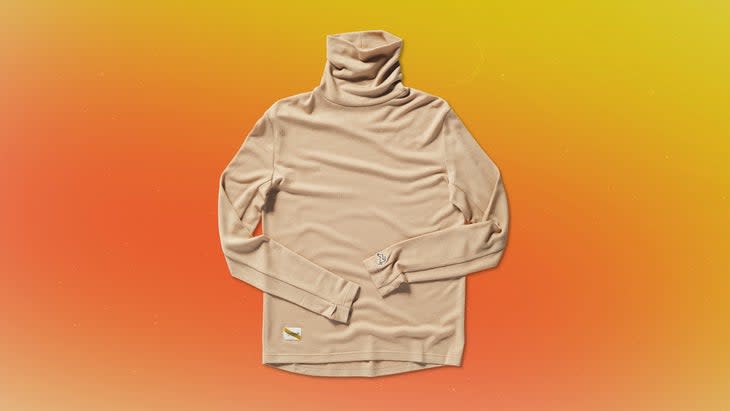
Weight: 8.7 oz
Sizes: S-XL
Turtlenecks were all the rage for English sportsmen in the 19th and early 20th century (think Chariots of Fire) but were coopted for daily wear by flappers, philosophers, and beatniks. Now, after a century-long wait, Tracksmith has reclaimed the turtleneck from the realm of fashion, and why not? Warm and versatile, the Fells Turtleneck is a performance-ready base layer that offers extra neck protection from howling winter winds, and helps prevent chafing from stiff jacket collars. Simply pull the neck up when you're starting cold, then roll it down as you warm up. It's made from a soft, lightweight blend (65 percent merino wool and 35 percent polyester) that's woven into a stylish, three-dimensional honeycomb jacquard, which helps move air and moisture--even when the neck is pulled up. It won't just stay fresh and dry quickly; it'll also look great at the post-group run happy hour.
Bottom Line: Combine fashion and function in preppy New England style
Janji Mercury Jogger ($98)
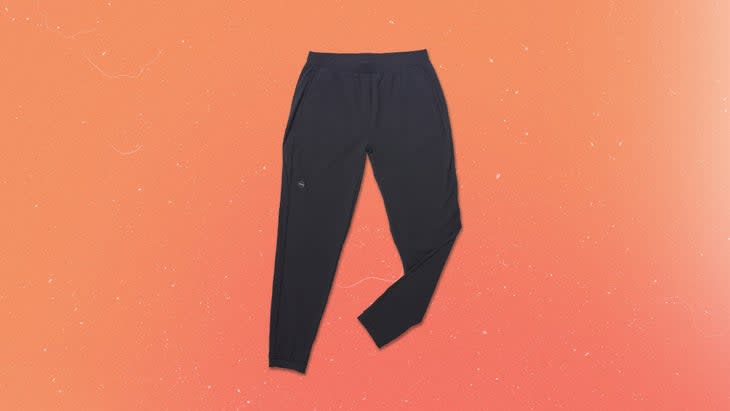
Weight: 9.9 oz
Sizes: S-XL
When you're not feeling the serious look of tights, Janji's best-selling pants have you covered. The Mercury Jogger quietly incorporates the technical performance of a cold-weather track pant into a deceivingly laidback, fashionable jogger that's so comfortable you'll want to wear it all day. This year, it's updated with softer fabric--a cozy, four-way stretch nylon-elastane blend on the outside and a polyester-elastane lining for next-to-skin comfort. Three secure zipper pockets, including an oversize lumbar that tames even plus-size smartphones, stow all your run necessities, and a crotch gusset frees you up to push the pace. As thin as it is, the Mercury is surprisingly versatile. It kept us warm in dry and snowy conditions alike, down to the teens Fahrenheit, and layered well over tights when the polar vortex came calling.
Bottom Line: All-day comfort without losing a second of performance on the run
District Vision Johannes Thermal Mid-Layer ($180)
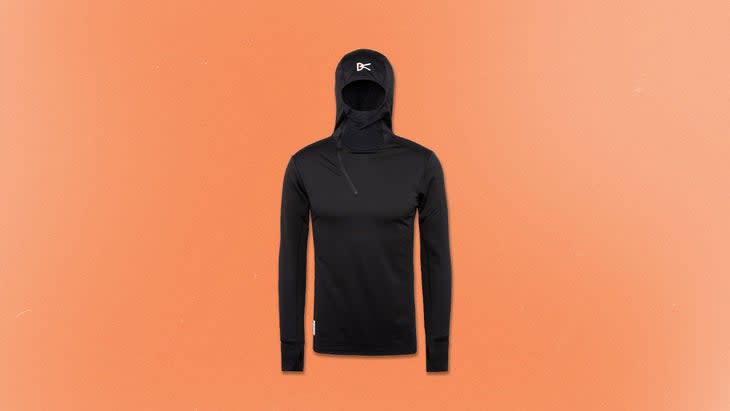
Weight: 13.1 oz
Sizes: S-XL
This cozy but breathable midweight (220gsm) hardface grid fleece hoody performs great on all sorts of cold-weather adventures--running, backcountry skiing, ice climbing--and looks fashionable to boot. Hidden tech details, like concealed thumbholes and integrated fold-over mitts, lend it versatility across variable conditions. But the real standout feature is the sculpted scuba hood, with its offset zip and integrated mesh neck gaiter that shields your mouth and nose from the weather while allowing you to breathe (and avoiding zipper chafe). Even fully ensconced, our testers had no problem huffing through the thin nylon mesh on hard, high-altitude runs--no foggy sunglasses, no wet, clammy material against their faces. The deep, offset chest zipper takes cues from the runway and, should you overheat, lets off steam. Extra style points for being 100 percent recycled.
Bottom Line: This versatile performer conquers cold weather from ridgeline to runway
Chrome Reflective 5 Panel Hat ($25)
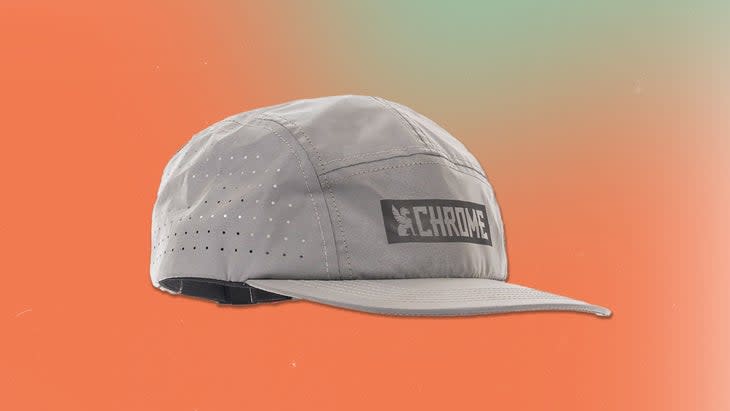
Weight: 2.6 oz
Sizes: One adjustable size
When your nighttime road runs resemble a game of Frogger, wear this reflective hat to transform your head into an attention-grabbing beacon that motorists can't ignore. Although the fabric may be less breathable than conventional running hats, the cotton-poly blend is lightweight but durable, and dozens of side-panel perforations help to air it out when your run heats up. Outside, the 360-degree reflective film is disco-ball-bright when hit by a light and--bonus!--sheds precipitation like a champ. When it's too cold for exposed ears, the adjustable fit with sturdy buckle closure allows you ample room to size up over a beanie.
Bottom Line: An attention-grabbing hat that steals the spotlight when sharing the road
CEP Compression The Run Compression 4.0 Socks (from $15)
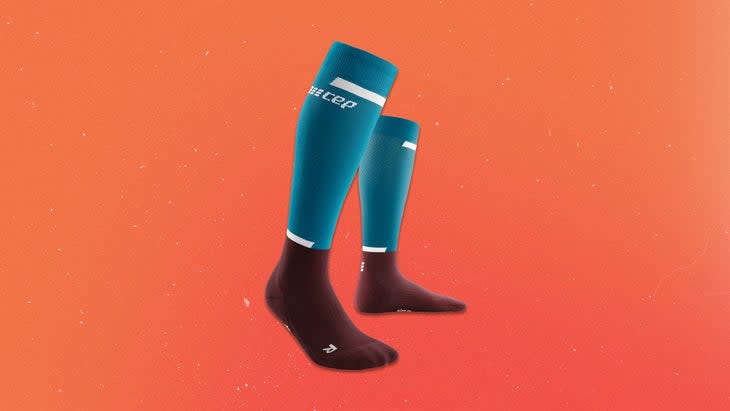
Weight: 2.6 oz
Sizes: S-XL
When is a sock more than a sock? According to compression-wear manufacturers, the answer is: when it's a pump working to increase blood circulation, reduce swelling, and remove lactic acid from your tissues. While evidence for those specific benefits isn't entirely clear, we can say with certainty that we love the look and feel of this pair. Super lightweight and thin, they feel cool on the foot, thanks to air channels in the footbed and ventilated toes and calves. Despite all that, they're substantial enough for wet, slushy road conditions, with targeted toe-to-heel padding underfoot that spares feet from pounding pavement, and arch and ankle compression that helps stabilize feet on snow-slick streets. When the run is done, moisture-wicking, silver-infused, polyamide-spandex fabric helps tame even the worst of foot funks.
Bottom Line: Sure-footed stability socks that may aid recovery
66o North Vik Gloves ($55)
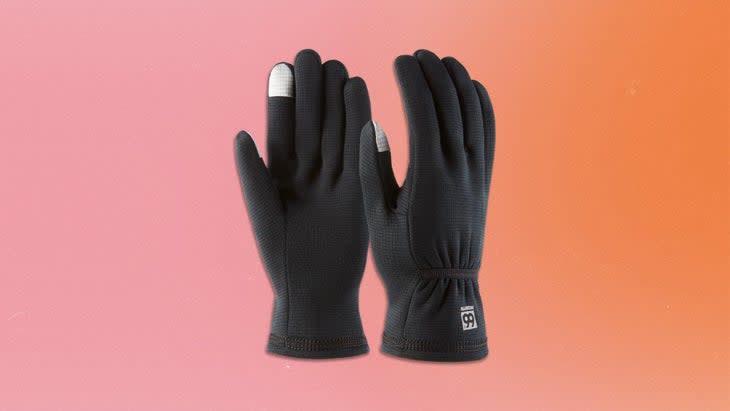
Weight: 1.3 oz
Sizes: XS-XXL
Wave goodbye to frostbitten fingers when you trade in your dime-a-dozen liner gloves for these fiery fleece beasts. The Viks are woven with Polartec's Wind Pro Stretch, a super tight-knit, stretchy fleece that repels all but the heaviest of downpours and resists wind, but still breathes enough to keep hands from getting clammy as the run progresses. Once you slide your hands inside the soft, cozy fleece, the touchscreen finger pads (that actually work!) mean you won't have to expose your digits to the cold to send a text or change podcasts. And when your sizzling pace heats you up too much for gloves, these lightweight babies stuff easily into a pocket until you're home.
Bottom Line: Phone-friendly fierce finger protection that won't broil your digits
Brooks Shield Hybrid Vest 2.0 ($115)
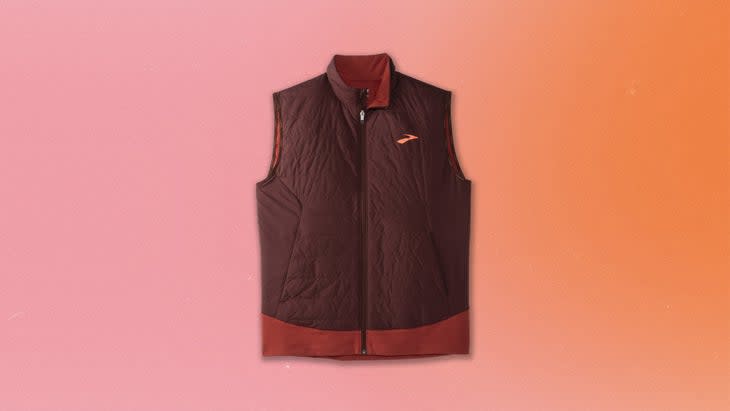
Weight: 8.9 oz
Sizes: XS-XXL
For those blustery late-fall days and early-spring gusters, layer this sharp-looking vest over your favorite long-sleeve for a surprisingly lightweight temperature--and fashion--boost. Wind- and water-resistant front panels insulated with 80-gram polyester fill keep your core warm, while polyester-spandex knit fabric along the sides and back boost mobility and help dump excess heat. If you're still running hot, simply unzip the front and fasten the dual snaps on the draft flap to hold things in place while you let off steam. Zippered hand pockets hold necessities safely, and when the run is done, this vest's refined finish transitions well to social settings.
Bottom Line: Warms your core, and looks good doing it
Roark Secondwind 2.0 Jacket ($125)
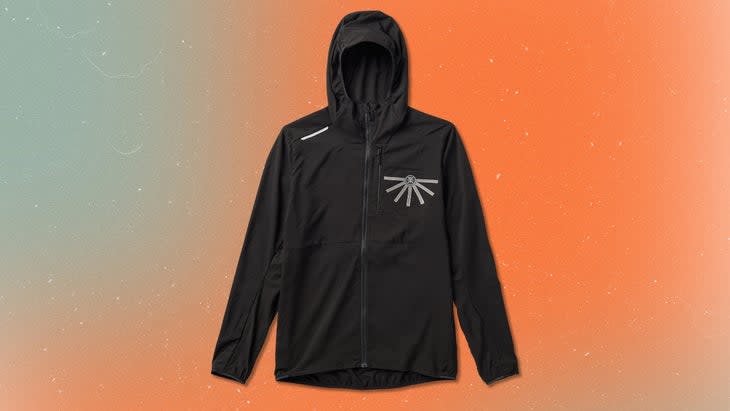
Weight: 4.9 oz
Sizes: XS-XXL
There's a whole category of minimalist stash-and-go shells that weigh less than a garbage bag, and--you guessed it--breathe almost as well. The ultralight Secondwind, on the other hand, lives up to its airy billing, blocking wintry winds and shedding light precip without turning you and the rest of your kit into a sweaty, overheated mess. A trim, athletic cut and stretchy ripstop polyester allow this jacket to move easily with you, while thoughtful details like thumb loops and elastic cuffs keep everything in place during hard efforts. While not entirely waterproof, its water-resistant DWR is good enough to keep snow, mixed precip, light rain, and even hit-and-run rain showers at bay. When the weather looks iffy, toss this barely-there beauty into your pack and hit the trails with confidence.
Bottom Line: A lightweight bad-weather insurance policy that moves and breathes better than most
Houdini Desoli Crew Baselayer ($100)
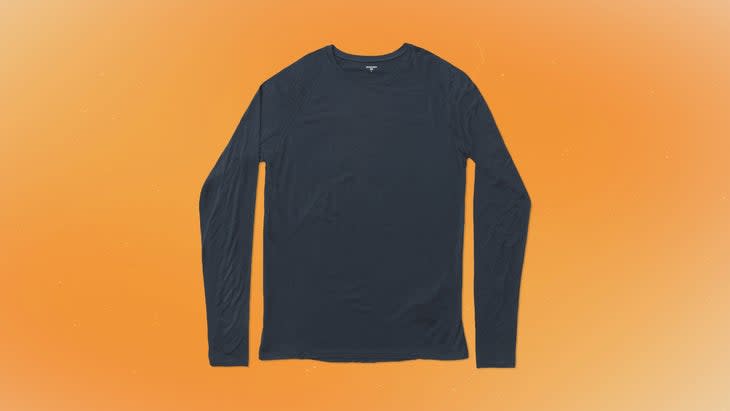
Weight: 6.2 oz
Sizes: XS-XXL
There are many well known attributes that make merino wool perfect for base layers: next-to-skin comfort, temperature regulation, odor resistance. In Houdini's case, it's also super sustainable. That's because the Swedish company never mixes the renewable wunderfabric with synthetics and doesn't process it with harmful dyes or chemicals, so it's 100 percent biodegradable or recyclable (the brand will gladly recycle it for you). While we love the Desloi Crew's lightweight, body-hugging fit and bunny-soft feel, we're just as stoked to know that, years from now, when this hard-wearing 100 percent merino shirt finally gives up the ghost, we can toss it into our backyard composter and it'll break down into soil.
Bottom Line: Guilt-free eco-friendly comfort and performance
Craft PRO Trail Tights M ($125)
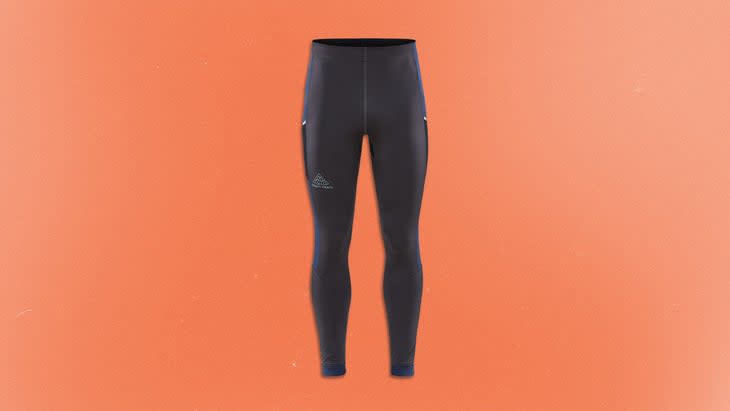
Weight: 7.7 oz
Sizes: XS-XXL
While fashion-forward joggers are having a well-deserved moment in road running circles, we prefer close-fitting tights on the trails, where they won't snag on underbrush or catch ridgeline gusts. This pro-grade pair ticks off most of our must-have features, including elasticated waistband and cuffs, zippered leg openings, and stretchy, stay-put thigh pockets to hold gels and other essentials on longer adventures. On top of all that, Craft add a zippered lumbar pocket that's waterproof for keeping electronics safe. Even cooler, this pocket is only sewn on at the top and bottom, with open sides that form a passthrough sleeve for stashing excess layers. Plus, its polyamide fabric is made of 72 percent recycled polyester-nylon blend sourced from recycled fishing nets and water bottles.
Bottom Line: Carries more stuff, more cleverly while running free on the trails
Norrona Falketind Alpha120 Zip Hood ($199)
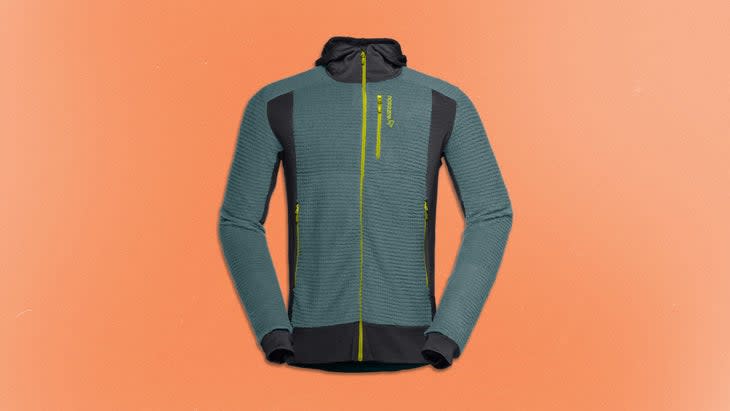
Weight: 9.8 oz (large)
Sizes: S-XXL
Designed for mountaineering, this hoody is named for a gorgeous 2,000-meter alpine pyramid near Norway's Jotunheimen National Park. But it also has top trail running chops. Designers blended Polartec's airy Alpha and stretchy Power Grid insulations to make a thin, outrageously warm fleece hoody that moves and breathes super well, easily layers under a weatherproof shell when braving blowing sleet or snow, and weighs next to nothing. In dry conditions, it kept us comfy as a standalone layer in temps as low as the mid-20s. Other great details include a zip chest and hand warmer pockets, plus integrated thumb loops and a close-fitting hood to lock in body heat when a cold front rolls in.
Bottom Line: Suitable for mountainous adventures, this midlayer hoards warmth without boosting weight on the trail
Sunday Afternoons Meridian Thermal Cap ($38)
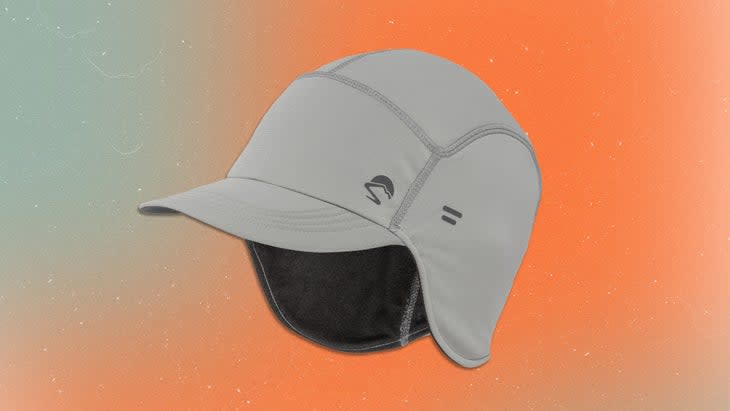
Weight: 1.7 oz
Sizes: one size
At last, a single winter cap that does the job of both an insulated beanie and a visored running hat equally well. The stretchy, breathable Meridian keeps your head warm with a buttery-soft microfleece lining and generous ear flaps that fold away when you get hot. Meanwhile, its 2.5-inch crushable brim deflects distracting sun and moisture from overhead, so you can focus your attention on roots and rocks underfoot. Reflective hits ensure you're visible between town and trailhead, while a concealed ponytail opening gives your Walmsley-inspired wildman bun room to roam.
Bottom Line: One winter hat to replace them all
Smartwool Run Targeted Cushion Socks ($18-23)

Weight: from 1.4 oz
Sizes: S-XL
Capitalizing on their hard-won expertise in merino wool and whizbang needlework, Smartwool may well have made the Goldilocks of winter running socks. Soft, cozy nylon-elastane-merino (56 percent of the latter) keeps your feet from freezing. Meanwhile, mesh venting on top allows them to breathe, and no-rub seams avoid pesky blisters. There's just enough extra cushion under the ball and heel of your foot to soften the blow of buff, hard-packed trails and blunt the sting of sharp rocks while still being nimble on the technical stuff. And we love that you can pick the right height for you: low, medium, or high.
Bottom Line: A just-right merino sock for almost any winter condition
Ledlenser NEO9R Running Headlamp ($150)
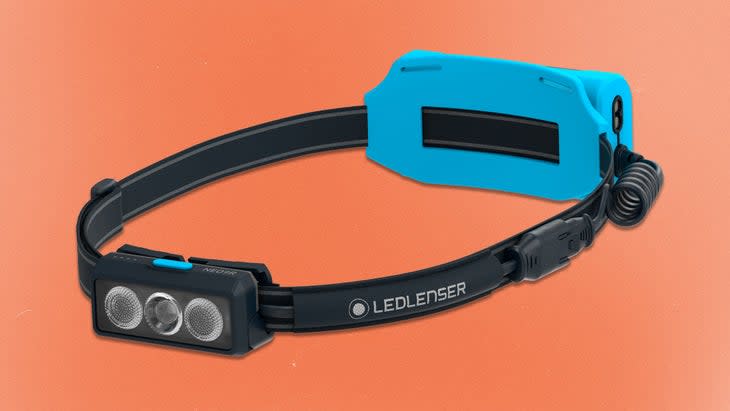
Weight: 7.0 oz
Sizes: one adjustable size
When it comes to pre-dawn and post-dusk runs, there's town dark and then there's trail dark--that deep, inky blackness you only seem to encounter on steep, technical terrain hours from the parking lot and miles from medical help. In times like these you'll want to have the powerful NEO9R headlamp strapped to your noggin. It casts a crisp, clear 600-lumen spot-flood beam on high setting, with an option to temporarily boost output to 1,200 lumens. And a massive 5,000 mAh battery pack promises to deliver the full 600 lumens for a five-hour epic--a claim that seemed accurate in our experience. (The replaceable battery pack recharges with a handy, magnetically-connected USB-C cord). All of that extra juice isn't light, but while the NEO9R feels heavy in the hand, it rides nicely balanced on the head, and an overhead strap minimizes bouncing. Plus, the reflective headband and a pulsing red safety light in back ensure you're seen on the trailhead commute.
Bottom Line: Push harder, for longer into the night, on technical terrain with this light
Patagonia Slope Runner Exploration Pack 18L ($179)
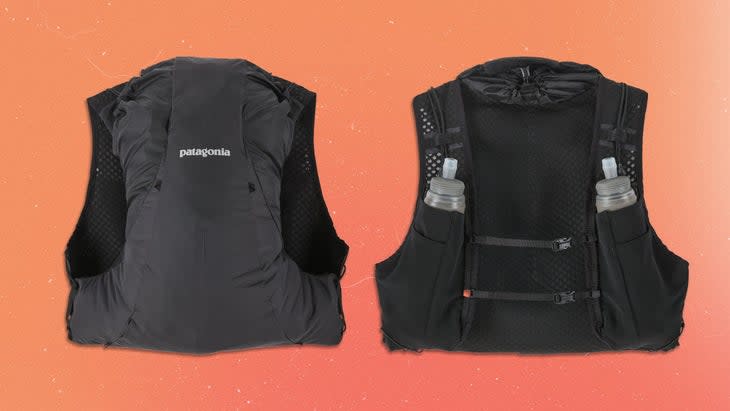
Weight: 1 lb, with bottles
Sizes: XS-L
Expanding on the sleek and comfortable running vest chassis of its Slope Runner series, Patagonia built this roomy trail vest-pack for long days out in big terrain, where loads of calories and extra layers are a necessity, and ice tools and other climbing gear might come into play. The rear storage configuration maximizes space and utility while minimizing bulk: a single zippered pocket for small essentials like keys and wallet, two exterior burrito holsters (or soft-flask sleeves, depending on your needs), and a cavernous main compartment for everything else. Dedicated lash points hold trekking poles and an ice axe for mixed terrain adventures. In front, four more pockets on the chest harness keep drinks, snacks, and phone close at-hand. Whether stuffed to capacity or almost empty, this pack rides high and bounce-free, thanks to on-the-go-adjustable stabilizing bungees that cinch the load forward and snugly to your back. Never before have you been able to carry so much into the backcountry so comfortably. Load it up, step outside, and prepare to push your limits.
Bottom Line: Best for long-day trail runs with alpine aspirations
How to Buy
Assembling a running kit is similar to putting together any winter apparel kit: staying warm in the elements is the first priority. Thanks to the high-intensity exertion of running, however, each piece needs to also breathe effectively, wick moisture aggressively, and easily move with your body. Here are three considerations that will help guide your purchases.
1. Layers, Layers, Layers!
Weather conditions--and, therefore, body temperature--are subject to fast and frequent changes over the course of a winter day, or a long run. Therefore, you'll want to have layers that you can put on or take off in response to the whims of the weather gods and how hard you're working.
Base/Bottom Layer -- Excessive sweating is the fastest way to lose body heat in the winter. To stay warm and comfortable, you need a next-to-skin layer that breathes well, wicks sweat away from your body, and, ideally, doesn't get stinky. For all of those qualities, we love merino wool. Look for something that feels soft and contains at least 50 percent of this wunderfiber. For those that don't like wool, there are many good synthetic alternatives, which tend to breathe slightly better but can have issues with odor retention.
Mid-Layer -- Typically the warmest layer, you'll want this cozy insulator to trap body heat while releasing sweat vapor and other moisture. Synthetic polyester fleece is a super versatile fabric that's most common for midlayers; besides being soft, lightweight, and highly breathable, it can be knitted in countless weights and patterns to achieve different attributes. Choose a fleece midlayer that breathes well, and is the right thickness for the temps you'll most likely be running in. Other features that can add versatility include a hood and foldover mitts for extra protection, and one or more zipper pockets for those fair-weather days when your midlayer might serve as an outer layer.
Outer Layer -- Alternatively called a shell, an outer layer is there to protect you and your soft inner layers from the elements. Depending on conditions, it might be a wind shell (cold and blustery, but dry), a water-repellent softshell (variable conditions) or a, three-layer rain shell (any PNW snow- or rainstorm, sleet, or the much-dreaded "wintry mix" common across the Midwest and Northeast). Whatever you get, you'll want it to lock out the elements while still breathing well enough to prevent overheating.
Bottoms -- Your legs work really hard when you run, and therefore rarely require more than a single layer to stay warm, even on the coldest of days. A pair of regular full-length running tights will suffice for most conditions. In extreme weather, you may want to opt for something more specialized, with wind-blocking fabric or a thick terry lining for extra warmth. Extra features to look for are zippered leg openings and convenient pockets (we love a zipper lumbar pocket).
Accessories -- For the rest of the gear, it's mostly about covering bare skin and finding the features you want. Gloves or mittens will keep your fingers warm, but ones with tech-friendly tips can continue to do so while you text or change podcasts. A simple insulated beanie will keep your head warm, but one with a visor can keep driving sleet and snow out of your eyes at the same time (if you wear sunglasses, hats with built-in sunglass locks help hold the temples comfortably in place). Buffs and other neck warmers can protect your neck from howling winds. Socks should be high enough that there's no exposed skin between their tops and the cuffs of pants; wool blends help keep your feet warm even when wet.
2. Know Your Conditions and Your Comfort Zones
What ultimately serves you best will come down to your local winter weather conditions and your personal comfort zones, so keep those in mind when making purchases. A three-layer rain shell, for example, probably isn't necessary for most runners in desert regions where it rarely rains, or those in warmer climates where getting wet isn't a problem. If in doubt, start simply with versatile pieces, and build out your kit as you better understand your conditions and your own limitations. Pay close attention to the weather immediately before stepping out each day, try to dress appropriately, and learn from your inevitable mistakes as you occasionally overheat, lose feeling in your hands, or get a wind-chapped face. After one or two winters outside, you'll have a system down pat and, while weather will always be a factor in your runs, it will no longer be a barrier to them.
3. Be Flexible, Be Safe, Be Seen
Weather aside, visibility is the other main factor to consider when buying winter running gear. During the darker months, it can be hard to find time between life's daily commitments to exercise during those limited daylight hours, which means we're often running when both visibility and temps are at their lowest. If you live in a place where it snows a lot and often, roads typically have the best footing, but also present the danger of cars. For that reason, you need to be seen to be safe.
Minimal reflective elements aren't enough, so try to avoid buying blacks and other drab shades that are hard to spot in the dark, and opt instead for bright, even reflective, colors that will draw motorists' attention and help keep you safe. A headlamp with a bright (250-lumen minimum on roads, 350-lumen minimum on trails) spotlight is useful for picking your way through ice, snow, and puddles and, as a bonus, announces you to other road users (I also consider a blinking red rear safety light a must).
All of that said, if you don't yet have proper safety gear or don't feel safe running after dark, try to be flexible with your schedule and make time for running when the sun's still out. Feeling that rush of crisp winter air in your lungs and soaking up some much-needed Vitamin D sure beats time on the "dreadmill," and goes a long way toward curing the winter blues.
More 2023 Winter Gear Guide Reviews
For exclusive access to all of our fitness, gear, adventure, and travel stories, plus discounts on trips, events, and gear, sign up for Outside+ today.

